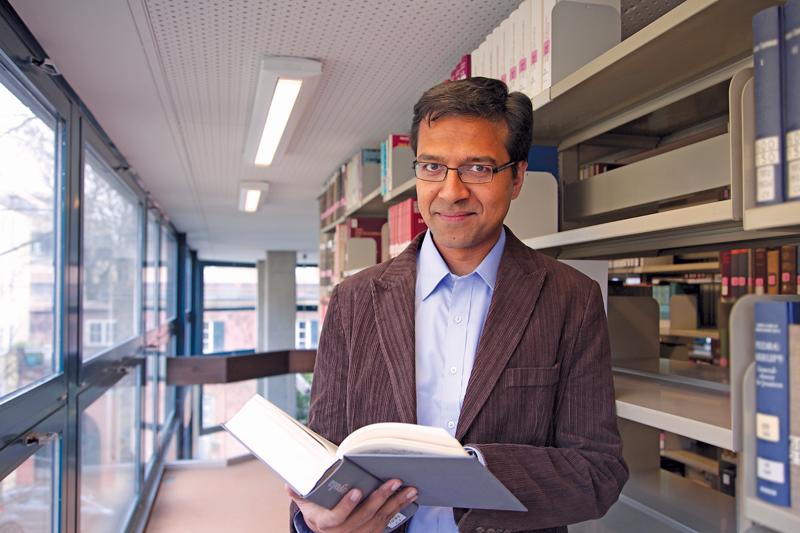“Philosophy and theology are required for studying to become a priest,” says Fr. Richard D’Souza. “Add in astronomy, and a third dimension becomes the norm.”
Come again?
D’Souza is both a Jesuit priest and an astronomer. He’s based at the Vatican Observatory in Rome but is currently doing a postdoc at the U-M, where he’s working with astronomy prof Eric Bell. Their collaboration made news internationally this summer when they published their discovery of a galaxy that largely vanished a couple of billion years ago. Space.com headlined the news this way: “The Milky Way Had a Big Sibling Long Ago–And Andromeda Ate It.”
Called “M32p,” it orbited Andromeda, our closest galactic neighbor–until, in the words of a U-M press release, Andromeda “shredded and cannibalized” it.
That happened two billion years ago, making M32p’s demise a very cold case. D’Souza and Bell cracked it using a combination of observational data and mathematical modeling.
“This is really great detective work!” exclaims U-M astronomy chair Edwin Bergin. “Looking at the available yet puzzling evidence and using it to look back in time to understand how our closest massive neighbor, the Andromeda Galaxy, formed and evolved.
“We know that a major, if not the major, way galaxies are constructed is by gravitational interactions with other galaxies, where the large galaxy strips material from the smaller one.
“So we now have evidence from the closest galaxy to us that suggests we need to revisit our understanding of how galaxies form. Science is great! We learn something new that points us in new directions.”
If people know anything about the Catholic Church’s connection to astronomy, it’s likely to be the 1633 trial of Galileo Galilei for the “heresy” of suggesting that the earth revolves around the sun. But the church has actively engaged in studies of the cosmos since the sixteenth century, with Jesuit priests at the forefront. Thirty-five craters on the moon are named after Jesuits, and D’Souza is one of twelve members of the order based at the Vatican Observatory.
D’Souza straddles the worlds of faith and science with no apparent tension. “There is something deep in each one of us which lights up when we look up at the night sky,” he says. “Ingrained in each one of us is a deep sense of amazement and wonder in the cosmos and the heavens.
“We are all searching for meaning in various ways. Science does not provide the meaning. Only the facts … Religion gives us a sound reason to do good science because it is an expression of the transcendent–which is God.”
D’Souza is in the second year of his three-year postdoc. He also serves on the pastoral staff at St. Mary Student Parish. That’s where I met him recently the night before he had to fly back to Rome.
Tall, with well-cut features, dressed in casual street clothes, D’Souza explains that he lives with other Jesuits just east of downtown and he enjoys taking walks and exploring different espresso shops. He’s made connections with staff and students he’s met at both U-M and St. Mary. But there’s not been much time for socializing.
“Galaxies grow by forming on their own or by merging with smaller galaxies over millions of years,” he explains. “I’ve been focused the past few years on smaller galaxies merging.” Andromeda drew his attention because it is thought to have formed from such mergers and has an intriguing “halo” of stars.
D’Souza describes the work with Bell (who was unavailable for an interview) as “fun and fascinating–but mainly consequential.” They gathered data from the Hubble Space Telescope and earth-based telescopes in Hawaii, then used math to simulate how the “halo” might have formed.
Their conclusion: both Andromeda’s halo and its small elliptical satellite, M32, were once part of a much larger spiral galaxy. Its “arms” of stars had been sucked into the larger galaxy, creating the halo. They dubbed that lost progenitor M32p.
—
D’Souza was born in Pune, India. Educated as a young boy in Kuwait, “in my early teens I was captivated at what the Jesuits had achieved.” He returned to India to attend a Jesuit school, entered the novitiate, and was ordained. Afterward he spent a year studying the humanities in Pune and then earned degrees in physics at St. Xavier’s College in Mumbai and the University of Heidelberg and a doctorate at the Max Planck Institute for Astronomy. Along the way, he founded a school in India that helps school dropouts find employment and earned two theology degrees.
Having a Jesuit priest in the limelight for a scientific breakthrough provided a bright spot in a difficult year for the Vatican; more sexual abuse scandals in the church were reported, and a couple of top officials stepped down. Says D’Souza, “This is a time of great pain and suffering for the Catholic Church … The only way forward is through a process of openness, listening, and reconciliation. It is not by hiding behind the power of the institution.”
He says his secular career, if anything, has brought him closer to his faith. “In my studies I have claimed as my own epiphany the story of how the Magi followed a star in seeking a newborn king,” he says. In the Christian Christmas story, “the Magi are the wise ones, people of philosophy and science who sought the truth greater than themselves. I would like to think that as a Jesuit astronomer I continue this tradition.”


